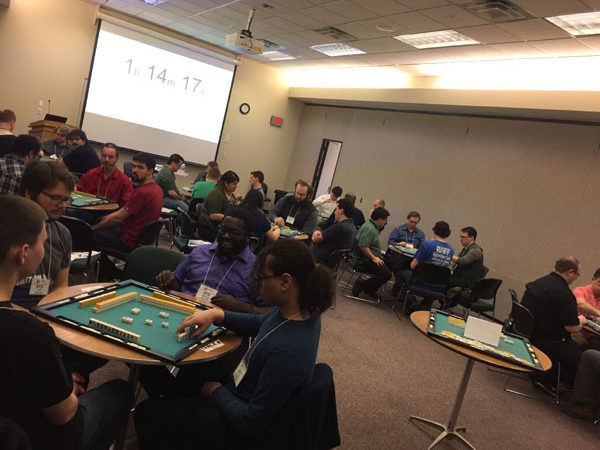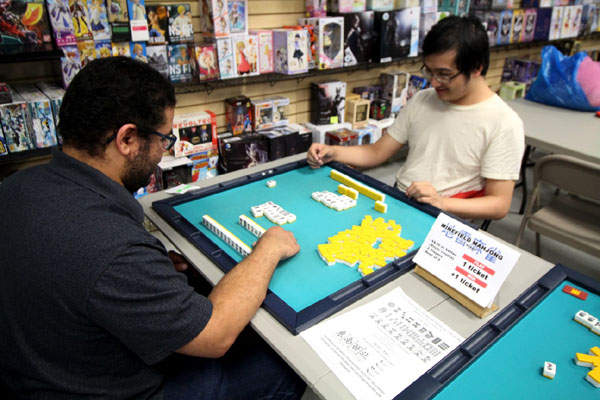The Care and Keeping of Your Mahjong Club
by Luke Morgan
Mahjong-NY.com
Over the past decade, our city’s mahjong groups (RIT Nine Gates and Mahjong @ Hammergirl Anime) have grown from a single table of friends to dozens of players, with new folks being taught every week. Rather than write about generic “how to start a club” ideas, I thought it might be helpful to share some of the opportunities and strategies that have worked for us (and one that didn’t) in hopes they might help out your club as well.
Always Have a Core Group to Play—and To Let Others Play
The most important thing for your club is that everyone who shows up sees people playing, and can get into a game. Early on, when the club fluctuated between one and two tables worth of people, there was a core group of folks that always showed to the meetings, and almost more importantly, would stand from their game at any time to teach or let someone sit in. Beginners could learn immediately, and new faces that already play could jump right in. The downside is you might be helping run a club but never actually get a game in yourself at a meeting. To alleviate that we post a second meeting time where all the club teachers and helpers get in a weekly game while they talk club business.
Adjust Your Teaching Style To Your Audience
In our area of the country, we have anime fans. Lots of them. Rochester has one of the largest weekly anime clubs in the nation, and one of the largest anime stores as well (of which I am the manager of, to be honest). The vast majority of people in our area come into mahjong because they saw it in an anime. As such, I teach with copious references to Akagi and Saki, and I don’t shy away from yaku and terminology and points calculations, because the people I usually teach are eager to hear about the complexity, seeing it as a challenge to overcome to more deeply connect with their other hobbies. However, if I am teaching someone stopping by a table at a boardgame event, I go with the Tibet Rules or Mahjong in Four Hands. For adults that I teach, I will liken the game to Gin Rummy, and so on. Looking at your teaching method from the outside perspective will help you reach (ha, “reach”) new players much more easily.
Work with Other Mahjong Clubs

If another club is within driving distance, get in touch with them to set up friendly combo events or visits. It will give your players experience with new people and play-styles, and there’s a good chance that your clubs have different club-specific advantages and disadvantages that you can help each other with. Our local clubs work with a newer club out of Lockport, the Western Dragon Mahjong Club, for everything from event staffing to equipment borrowing.
Always Be Recruiting
Even if you have a good group of people playing, you should always be on the lookout for new members. Flyers, announcements at other clubs, Bring-A-Friend days, and so on will ensure that you continually get new people in. Not only does this allow your members to play against new folks, it also prevents the fallout from a big group that joined the club all at once leaving the club all at once. While this is most prevalent in college clubs (as the years of students graduate) it also makes sure your club does not hinge on any individual clique of people. For example, our club had an issue a number of years ago when a portion of it became obsessed with a particular video game, and would skip club to play it.
Capitalize from Mahjong In The News
Crazy Rich Asians, the launch of the Akagi live-action, mahjong in Final Fantasy 14—every one of these brought the club an influx of members who want to know more. Capitalize on it. Prepare to answer the questions of people coming in from these other newsworthy events and get them playing.
Have Something to Do for All Player Counts

When your club is smaller, you might have an odd count of players. Staggered, shorter games, or alternate things to do for players waiting for a game will keep people feeling that the club is a worthwhile use of their time. It’s no fun to show up for a club and then have to wait two hours to get in a game. Two-player setups, manga / strategy books, East-only games, getting up to let a new player sit-in, or even a computer set up with something to log into and play (a club Ron2, Mahjong Soul, or Tenhou account) will keep people happy and occupied while they wait to play.
Training Games
In mahjong, a large difference in skill levels can make it so a newer player might be unable to ever win a hand against more experienced opponents, and you might not have a full table of newer players to play together. In cases like these, rather than frustrate a newer player with never reaching tempai, it can help to have some of your teachers “dial it back” so that newer players can get a chance to build and attempt to win a hand—or if the newer player is interested, go over basic tile efficiency and “walk in” a few hands to show them how things could have gone.
Connect with National Organizations
There’s probably an umbrella organization in your country with teaching tips, tourney resources, and does the legwork for promoting and getting invites to larger events. Let them know about your club and when your events are taking place to get information about your club out to as many folks as possible.
Identify Things That Work and Things That Don’t
Make sure you keep an eye on what’s going on at your club so you can change things that need changing. For example, many years ago the local club recorded every game and kept a running track. While a number of players did appreciate the score keeping, we found that recording every game caused some folks to be upset or stress out about their placement, so we replaced that with an opt-in featured “league game” and periodic tournaments.
I hope this helps with your clubs, old and new—we’re all in this together!
